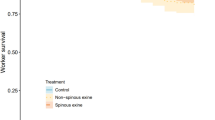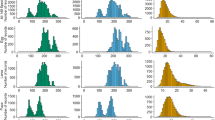Abstract
Mealybugs have strong associations with their host plants due to their limitations for dispersal. Thus, environmental conditions and host quality may impact the biological traits of mealybugs. To the best of our knowledge, we are the first to report on the biology of a Brazilian population of the striped mealybug Ferrisia virgata Cockerell (Hemiptera: Pseudococcidae), which has recently been reported to infest cotton in Brazil. We evaluated the development and reproductive performance of F. virgata reared under different temperatures (25, 27, and 28°C) and mating status. The type of reproduction was also studied with insects reared on a factitious host and on cotton plants. Shorter development was obtained at 28°C as follows: nymphs generating males and females exhibited three and four instars with a mean duration of 19.1 and 20.5 days, respectively. The nymphal viability ranged from 77 to 96%, and was highest at 25°C. Females reared at 28°C initiated reproduction earlier (16.4 days), but the reproductive period was similar in all temperatures (∼16.2 days). Females produced more nymphs at 27 and 28°C (440 and 292 neonates) than at 25°C (277 neonates), although they lived longer at 25°C (63 days). Ferrisia virgata females exhibited only sexual reproduction. Thus, only mated females produced offspring, whereas unmated females died without reproducing. Therefore, the studied population of F. virgata exhibited only sexual reproduction with high survival and offspring production when fed cotton. Furthermore, pumpkin is a feasible host for mass rearing this mealybug species in the laboratory, an opening avenue for future studies.
Similar content being viewed by others
References
Abbas G, Arif MJ, Saeed S (2005) Systematic status of new species of genus Phenacoccus Cockerell (Pseudococcidae), a serious pest of cotton Gossypium hirsutum L. in Pakistan. Pak Entomol 27:83–84
Awadallah KT, Ammar ED, Tawfik MFS, Rashad A (1979) Life-history of the white mealybug Ferrisia virgata (Ckll.) (Homoptera, Pseudococcidae). Disch Entomol Z N F 26:101–110
Barbosa PRR (2012) Desempenho de Tenuisvalvae notata (Mulsant) (Coleoptera: Coccinellidae) em diferentes presas e sua predação sobre Ferrisia virgata Cockerell (Hemiptera: Pseudococcidae). Mestrado. Dissertação, Universidade Federal Rural de Pernambuco
Ben-Dov Y, Miller DR, Gibson GAP (2012) ScaleNet, Pseudococcidae catalogue. <http://www.sel.barc.usda.gov/scalenet/scalenet.htm. Ferrisia virgata: http://www.sel.barc.usda.gov/catalogs/pseudoco/Ferrisiavirgata.htm> Accessed 20 December 2012
Calatayud PA, Delobel B, Guillaud J, Rahbe Y (1998) Rearing the cassava mealybug, Phenacoccus manihoti, on a defined diet. Entomol Exp Appl 86:325–329
Chong JH, Roda AL, Mannion CM (2008) Life history of the mealybug, Maconellicoccus hirsutus (Hemiptera: Pseudococcidae), at constant temperatures. Environ Entomol 37:323–332
CPC (Crop Protection Compendium) (2012) <http://www.cabi.org/cpc/>. Accessed 20 December 2012
Culik MP, Martins DS, Ventura JA, Peronti ALBG, Gullan PJ, Kondo T (2007) Coccidae, Pseudococcidae, Ortheziidae, and Monophlebidae (Hemiptera: Coccoidea) of Espírito Santo, Brazil. Biota Neotrop 7:61–65
Das GM, Mukherjee TD, San Gupta N (1948) Biology of the common mealybug, Ferrisiana virgata (Ckll.), (Coccidae), a pest on jute (Corchorus olitorius) in Bengal. Proc Zool Soc Bengal 1:109–115
Figadère BA, McElfresh JS, Borchardt D, Daane KM, Bentley WJ, Millar JG (2007) Identification and synthesis of trans-α-necrodyl isobutyrate, the sex pheromone of the grape mealybug, Pseudococcus maritimus. Tetrah Lett 48:8434–8437
Fuchs TW, Stewart JW, Minzenmayer R, Rose M (1991) First record of Phenacoccus solenopsis Tinsley in cultivated cotton in the United States. Southwest Entomol 16:215–221
Ghouri ASK (1960). Insect Pests of Pakistan. FAO Bangkok, Thailand, (Technical Bulletin 8, FAO Regional Office for Asia and the Far East), 30 p
Highland HA (1956) The biology of Ferrisiana virgata, a pest of azaleas. J Econ Entomol 49:276–277
Hinkens DM, McElfresh JS, Millar JG (2001) Identification and synthesis of the sex pheromone of vine mealybug, Planococcus ficus. Tetrah Lett 42:1619–1621
Hodgson C, Abbas G, Arif MJ, Saeed S, Karar H (2008) Phenacoccus solenopsis Tinsley (Sternorrhyncha: Coccoidea: Pseudococcidae), an invasive mealybug damaging cotton in Pakistan and India, with a discussion on seasonal morphological variation. Zootaxa 1913:1–35
Kirkendall LR, Normak B (2003) Parthenogenesis. In: Resh VH, Cardé RT (eds) Encyclopedia of insects. Academic, San Diego, pp 851–856
Kumar R, Jat SL, Pal V, Chauhan R (2010) Biology of the mealybug, Phenacoccus solenopsis Tinsley (Hemiptera: Pseudococcidae) in India. Entomon 34:189–192
Lloyd DC (1952) Parthenogenesis in the mealybug, Phenacoccus solani Ferris. Can Entomol 84:308–310
Malleshaiah B, Rajagopal K, Gowda KNM (2000) Biology of citrus mealybug, Planococcus citri (Risso) (Hemiptera: Pseudococcidae). Crop Res 20:130–133
Millar JG, Midland SL (2007) Synthesis of the sex pheromone of the obscure mealybug, the First example of a new class of monoterpenoids. Tetrah Lett 48:6377–6379
Millar JG, Midland SL, McElfresh JS, Daane KM (2005) (2,3,4,4-Tetramethylcyclopentyl) methyl acetate, a sex pheromone from the obscure mealybug: First example of a new structural class of monoterpenes. J Chem Ecol 31:2999–3005
Millar JG, Moreira JA, McElfresh JS, Daane KM, Freund AS (2009) Sex pheromone of longtailed mealybug: a new class of monoterpene structure. Org Lett 11:2683–2685
Nikam ND, Patel BH, Korat DM (2010) Biology of invasive mealybug, Phenacoccus solenopsis Tinsley (Hemiptera: Peseudococcidae) on cotton. Karnataka J Agri Sci 23:649–651
Normark BB, Johnson NA (2011) Niche explosion. Genetica 139:551–564
Nur U (1971) Parthenogenesis in Coccids (Homoptera). Am Zool 11:301–308
Padi B (1997) Parthenogenesis in mealybugs occurring in cocoa. In: Owusu GK, Padi B, Ollennu LAA, Owusu Manu E (eds) Proceedings of the First International Cocoa Pests and Diseases Seminar. Accra, Ghana, pp 242–248
Prasad YG, Prabhakar M, Sreedevi G, Ramachandra Rao G, Venkateswarlu B (2012) Effect of the temperature on development, survival and reproduction of the mealybug, Phenacoccus solenopsis Tinsley (Hemiptera: Pseudococcidae) on cotton. Crop Prot 39:81–88
Puterka GJ, Hammon RW, Burd JD, Peairs FB, Randolph TL, Cooper WR (2012) Cyclical parthenogenetic reproduction in the Russian wheat aphid (Hemiptera: Aphididae) in the United States: sexual reproduction and its outcome on biotypic diversity. J Econ Entomol 105:1057–1068
Rawat RR, Modi BN (1969) Studies on biology of Ferrisia virgata Ckll. (Pseudococcidae: Homoptera) in Madhya Pradesh. Indian J Agr Sci 6:274–281
SAS Institute (2001) SAS/STAT User’s guide, version 8.02, TS level 2MO. SAS Institute Inc., Cary, NC
Silva EB, Mendel Z, Franco JC (2010) Can facultative parthenogenesis occur in biparental mealybug species? Phytoparasitica 38:19–21
Silva-Torres CSA, Oliveira MD, Torres JB (2013) Host selection and establishment of striped mealybug, Ferrisia virgata, on cotton cultivars. Phytoparasitica 41:31–40
Torres JB, Oliveira MD, Lima MS (2011) Cochonilhas Farinhentas: potenciais problemas para o algodão brasileiro. Recife, Universidade Federal de Pernambuco, 6p. (Informativo REDALGO 005)
Trionnaire GL, Hardiet J, Possamai SJ, Simon JC, Tagu D (2008) Shifting from clonal to sexual reproduction in aphids: physiological and developmental aspects. Biol Cell 100:441–451
Vennila S, Deshmukh AJ, Pinjarkar D, Agarwal M, Ramamurthy VV, Joshi S, Kranthi KR, Bambawale OM (2010) Biology of the mealybug, Phenacoccus solenopsis, on cotton in the laboratory. J Insect Sci 10:1–9
Wang Y, Gillian W, Runzhi Z (2010) The potential distribution of an invasive mealybug Phenacoccus solenopsis and its threat to cotton in Asia. Agric For Entomol 12:403–416
Waterworth RA, Millar JG (2012) Reproductive biology of Pseudococcus maritimus (Hemiptera: Pseudococcidae). Hortic Entomol 5:949–956
Waterworth RA, Wright IM, Millar JG (2011) Reproductive biology of three cosmopolitan mealybug (Hemiptera: Pseudococcidae) species, Pseudococcus longispinus, Pseudococcus viburni, and Planococcus ficus. Ann Entomol Soc Am 104:249–260
Williams DJ, Granara De Willink MC (1992) Mealybugs of Central and South America. CAB International, London, 635 p
Wu AS, Zhang RZ (2009) A new invasive pest, Phenacoccus solenopsis threatening seriously to cotton production. Chinese Bull Entomol 46:159–162
Zaka SM, Saeed S, Bukhari SA, Baksh E (2006) Mealybug, Phenacoccus solenopsis (Homoptera: Pseudococcidae): A novel pest of cotton in Pakistan. In: Proceedings of 34th Pakistan (SAARC) Countries Science Conference. University of Veterinary and Animal Sciences. Lahore, Pakistan, 32 p
Acknowledgments
We express our deep appreciation to Dr Alessandra Rung (Plant Pest Diagnostics Branch, California Department of Food and Agriculture, Sacramento, CA) and Douglas Miller (Systematic Entomology Laboratory, ARR-USDA, Beltsville, MD) for identifying the striped mealybug species. Additionally, we thank the “Fundação de Amparo à Ciência e Tecnologia do Estado de Pernambuco (FACEPE)” and the “Coordenação de Aperfeiçoamento de Pessoal de Nível Superior (CAPES)” Foundation for providing grants to the first and third authors, respectively, and research funds APQ-0538-5.01/10 and PNPD no. 02544/09-1 to conduct this work.
Author information
Authors and Affiliations
Corresponding author
Additional information
Edited Kleber Del Claro – UFU
Rights and permissions
About this article
Cite this article
Oliveira, M.D., Barbosa, P.R.R., Silva-Torres, C.S.A. et al. Performance of the Striped Mealybug Ferrisia virgata Cockerell (Hemiptera: Pseudococcidae) under Variable Conditions of Temperature and Mating. Neotrop Entomol 43, 1–8 (2014). https://doi.org/10.1007/s13744-013-0171-z
Received:
Accepted:
Published:
Issue Date:
DOI: https://doi.org/10.1007/s13744-013-0171-z




